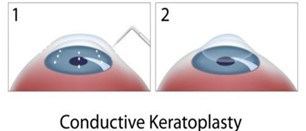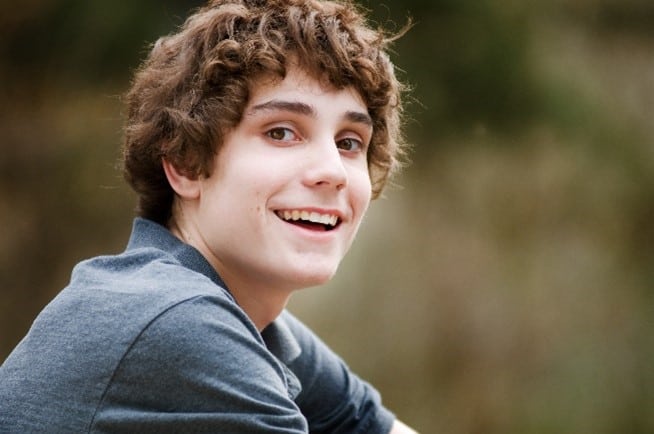 Astigmatism is a common vision problem that causes blurry and/or distorted vision due to an irregularly shaped cornea or lens. Because keratoconus is a gradual bulging of the cornea, which eventually takes on a cone-like shape, patients who have this condition inevitably develop worse vision through astigmatism.
Astigmatism is a common vision problem that causes blurry and/or distorted vision due to an irregularly shaped cornea or lens. Because keratoconus is a gradual bulging of the cornea, which eventually takes on a cone-like shape, patients who have this condition inevitably develop worse vision through astigmatism.
At my Beverly Hills practice, I, Dr. Brian Boxer Wachler, help my patients with keratoconus to overcome their .astigmatism and related vision problems by performing conductive keratoplasty (CK). CK is a minimally invasive procedure that uses radiofrequency energy to improve the astigmatism shape of the cornea.
Originally, doctors conceived of CK to address refractive errors like presbyopia and farsightedness. However, as our understanding of keratoconus evolved, it became clear to me that conductive keratoplasty could be useful in treating this condition as well.
CK Procedure Details
First, I administer numbing eye drops so that the patient’s eyes remain comfortable throughout the procedure. Next, with the help of a thin probe, I precisely deliver radiofrequency heat to the cornea. (RF energy is extremely safe and is currently used in a variety of medical procedures.) In just a few minutes per eye, CK shrinks targeted areas of the corneal tissue to improve the cornea’s curvature.
How Conductive Keratoplasty Helps
 The positive effects of CK can be seen quickly. The strategically administered heat improves the shape of the cornea, which typically helps my patients to achieve better vision with less astigmatism. Minimizing the bulging of the cornea is also beneficial with Intacs. Intacs are miniature, crescent-shaped inserts placed in the cornea to further flatten it and improve vision. I often perform these two procedures in conjunction on the same day to optimize the benefits.
The positive effects of CK can be seen quickly. The strategically administered heat improves the shape of the cornea, which typically helps my patients to achieve better vision with less astigmatism. Minimizing the bulging of the cornea is also beneficial with Intacs. Intacs are miniature, crescent-shaped inserts placed in the cornea to further flatten it and improve vision. I often perform these two procedures in conjunction on the same day to optimize the benefits.
CK Recovery
The patient’s vision is usually strong within a day of having the procedure (depending on the stage of their keratoconus), though it can take multiple weeks to completely stabilize. Most people feel well enough to resume their normal activities, including work, within a couple of days. I will continue to monitor your eyes with follow-up appointments (or if you are from out-of-town we can help arrange a follow-up doctor near you) to make sure the procedure has been successful and healed as expected.
Why Dr. Brian Does CK Better Than Other Doctors
My complication rate for conductive keratoplasty is exceedingly low (we’ve never had an infection) since the procedure does not require a laser or blade to reshape the cornea. I can immediately confirm that the shape of the cornea has improved after the procedure.
The main benefit of choosing me for this procedure is that I combine it with Holcomb C3-R, a proprietary treatment that helps to lock in the effects of CK for maximum improvement. Since many CK patients find that their results regress over time, it is important to enhance the procedure with Holcomb C3-R so that the results are longer lasting.
Get 3 Latest Best-Selling Keratoconus Books For Free!
(Plus a Complimentary Consultation – Value $307.00)
These books normally range from $15.99 to $22.95 each plus shipping



Am I a Candidate for Fortified Conductive Keratoplasty (CK)?
 Fortified conductive keratoplasty (CK) may be recommended for patients who would love to go back to the days of being able to read without glasses or “cheaters”.Ideal candidates share the following characteristics:
Fortified conductive keratoplasty (CK) may be recommended for patients who would love to go back to the days of being able to read without glasses or “cheaters”.Ideal candidates share the following characteristics:
- 40 years of age or older
- Have presbyopia
- Require correction between +.75 and +2.50
- Able to accept that some use of reading glasses may still be necessary under certain situations
Watch Dr. Brian’s webinar, How to Conquer Keratoconus
Fortified CK vs Fortified LASIK
Fortified CK and Fortified LASIK share the same goal of improving vision. Each procedure can be completed in little time and with minimal downtime, allowing the patient to start enjoying better vision soon after treatment. Each procedure uses Dr. Brian’s proprietary accelerated Holcomb C3-R cross-linking to strengthen the cornea that’s designed for long-lasting results.
However, this is where the comparisons end; the two procedures vary in their approach to treating refractive errors. Whereas Fortified CK utilizes low-energy radio waves to improve the contour of the cornea, allowing patients to experience clearer vision, LASIK achieves this goal with an excimer laser that is used to alter the cornea’s shape by removing tissue and creating a flap. Dr. Brian’s philosophy has always been if the same or similar result can be achieved with a less invasive approach, then let’s do that one! Fortified CK is often performed as an alternative to other refractive procedures, and unlike LASIK, does not involve removing tissue from the eye.
Preparing for Fortified CK
Before Fortified CK, you will need a complete eye examination, which may include a variety of tests such as a visual acuity test, slip lamp test, cornea topography and tonometry.
Does Fortified CK Hurt?
Dr. Brian is committed to ensuring his patients’ safety and comfort. When undergoing a conductive keratoplasty procedure, your eyes will be numbed so that it is painless and you are at ease the entire time. The procedure lasts about seven minutes, and many patients report only minimal discomfort following treatment.
Risks and Benefits
 There are risks associated with any procedure; however, most of the side effects, if any, that may result from Fortified CK are temporary, such as:
There are risks associated with any procedure; however, most of the side effects, if any, that may result from Fortified CK are temporary, such as:
- Sensitivity to light
- Changes in vision
- Nearsightedness
- Foreign object sensation in the eye
- Minimal discomfort after the procedure
Fortified CK provides a range of benefits that can greatly improve quality of life. These include:
Excellent results: This treatment is as effective as other vision correction options, including those that may not be suitable for conductive keratoplasty patients.
Low risk of complications: It is common for patients to experience minor side effects, but these tend to only last for the first few days following surgery.
Reduced dependence on glasses: A major benefit of this procedure is its ability to help patients reduce their need for eyeglasses. It can also slow the progression of presbyopia.
Re-treatments are typically not needed: Patients typically enjoy their results without needing subsequent treatments due to complications or less-than-ideal outcomes. In case a retreatment is needed, it is just as easy as having it the first time.
Conductive Keratoplasty Cost
 Fortified CK is considered an elective procedure, meaning insurance may not cover it, but the exact cost of the procedure depends on several variables, including the surgeon’s expertise, location, and the details of your treatment plan. Contact Dr. Brian’s office for details at 310-860-1900, text 424-245-0171, or email info@boxerwachler.com.
Fortified CK is considered an elective procedure, meaning insurance may not cover it, but the exact cost of the procedure depends on several variables, including the surgeon’s expertise, location, and the details of your treatment plan. Contact Dr. Brian’s office for details at 310-860-1900, text 424-245-0171, or email info@boxerwachler.com.
Make an Appointment to Discuss CK with Me
I urge all patients with keratoconus to seek prompt treatment to better preserve their eyesight. If your keratoconus has given you distorted vision with astigmatism, the good news is that conductive keratoplasty can play a significant role in improving the way you see. Together, we can devise a thorough treatment plan to limit and overcome the problems posed by keratoconus. To make an appointment with one of the country’s foremost keratoconus experts, please call 424-274-0958, text 424-245-0171 or email info@boxerwachler.com for a consultation.
FAQs
What causes keratoconus to develop?
Keratoconus is believed to be caused by a combination of genetic and environmental factors. It often appears during the teenage years and can worsen over time.
How soon can I return to work or school after the procedure?
Most patients return to normal activities, including work or school, within 1–2 days following CK.
How is keratoconus different from astigmatism?
While both affect the shape of the cornea, keratoconus involves progressive thinning and bulging, whereas astigmatism is typically a more stable and symmetrical shape irregularity. Keratoconus causes astigmatism.
Can keratoconus affect both eyes equally?
Yes but , it commonly affects both eyes asymmetrically with the severity may differ between them. This occurs because keratoconus starts in one eye first that is the eye that has more severity.
Is keratoconus hereditary or genetic?
Genetics can play a role, as keratoconus often runs in families about 15-20% of the time.
How is CK different from laser eye surgery?
CK does not use lasers or involve cutting the cornea. Instead, it relies on radiofrequency energy, making it less invasive to reshape the cornea.
Who is a good candidate for CK?
You may be a good candidate if you have moderate to severe keratoconus and are looking for a non-surgical vision improvement option.
Can CK treat both astigmatism and keratoconus at the same time?
Yes, CK can help improve vision affected by both conditions, especially when used as part of a customized treatment plan.
How long does the CK procedure take?
Each eye takes less than five minutes to treat.
Is CK painful or uncomfortable?
CK is not painful. Before the procedure begins, numbing eye drops are applied to ensure your comfort. Most patients describe feeling only mild pressure or warmth during the treatment. There is no cutting or stitching involved, and the use of radiofrequency energy instead of a laser contributes to the minimally invasive nature of the procedure.
What is the recovery time after CK?
Recovery is usually quick, with many people resuming daily activities within 1–2 days.
How soon will I notice results from CK?
You may notice vision improvement within a few days, though results vary.
Can CK be combined with other procedures like Intacs or Holcomb C3-R?
Yes, combining CK with other treatments can enhance results and stabilize your vision.
Are the results from CK permanent?
CK results are long-lasting, but keratoconus progression may require future treatment. This is the reason it’s important to combine it with Holcomb C3 R cross-linking.
What are the risks or side effects of conductive keratoplasty?
Mild discomfort, temporary blurry vision, and light sensitivity are possible but usually temporary. No one has ever gone blind from this procedure.
How does CK improve the shape of the cornea?
CK shrinks collagen in specific corneal areas, tightening and reshaping the cornea.
Is CK safe for advanced stages of keratoconus?
It’s typically more effective in moderate to severe stages. Dr. Brian will assess your condition to determine suitability.
Will I still need glasses or contacts after CK?
Some patients may still require corrective lenses, but your prescription may be reduced.
How often are follow-up appointments required after CK?
Initial follow-ups occur within days, with additional check-ins based on your recovery and vision stability.
What makes Dr. Brian’s CK approach different from others?
Dr. Brian customizes every treatment, combining his experience with innovative techniques to deliver exceptional care.


